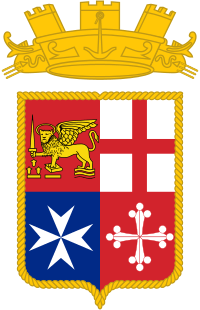Italian training ship Amerigo Vespucci
 Amerigo Vespucci | |
| History | |
|---|---|
| Name: | Amerigo Vespucci |
| Namesake: | Amerigo Vespucci |
| Laid down: | 12 may 1930 |
| Launched: | 22 february 1931 |
| Commissioned: | 26 may 1931 |
| Status: | in service |
| General characteristics | |
| Class and type: | Full rigged ship |
| Displacement: | 4,146 tonnes (9,140,000 lb) |
| Length: |
82.4 m (270 ft) 101 m (331 ft) including bowsprit |
| Beam: | 15.5 m (51 ft) |
| Height: | 54.0 m (177.2 ft) |
| Draught: | 7.0 m (23.0 ft) |
| Propulsion: | |
| Speed: |
|
| Complement: |
|
| Sensors and processing systems: | 2 x navigation radars GEM Elettronica AN/SPN-753(V)5 |
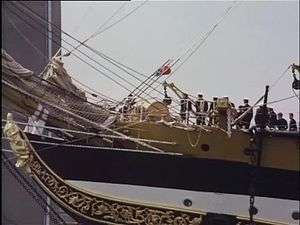
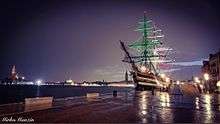



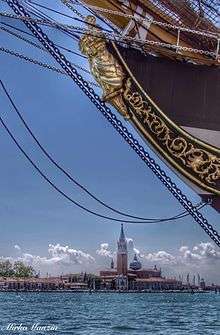


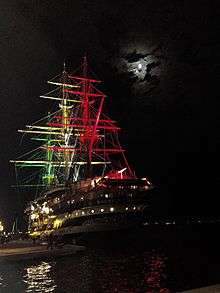
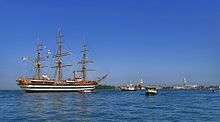
The Amerigo Vespucci is a tall ship of the Marina Militare, named after the explorer Amerigo Vespucci. Its home port is La Spezia, Italy, and it is in use as a school ship.

History
In 1925, the Regia Marina ordered two school ships to a design by General Lieutenant Francesco Rotundi of the Italian Navy Engineering Corps, inspired by the style of large late 18th century 74-cannon ships of the line (like the neapolitan ship "Monarca"). The first, the Cristoforo Colombo, was put into service in 1928 and was used by the Italian Navy until 1943. After World War II, this ship was handed over to the USSR as part of the war reparations and was shortly afterwards decommissioned.
The second ship was the Amerigo Vespucci, built in 1930 at the (formerly Royal) Naval Shipyard of Castellammare di Stabia (Naples). She was launched on February 22, 1931,[1] and put into service in July of that year.
The vessel is a full rigged three-masted steel hull 82.4 m (270.34 ft) long, with an overall length of 101 m (331 ft) including the bowsprit and a maximum width of 15.5 m (51 ft). She has a draught of about seven metres (23 ft) and a displacement at full load of 4146 tons. Under auxiliary diesel-electric propulsion the Amerigo Vespucci can reach 10 knots (19 km/h) and has a range of 5450 nm at 6.5 knots.
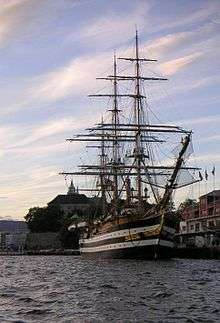
The three steel masts are 50, 54 and 43 metres high, and carry sails totalling 2824 m² (30400 ft²) The Amerigo Vespucci has 26 sails – square sails, staysails, and jibs: all are traditional canvas sails. When under sail in severe sea and wind conditions she can reach 12 knots (22 km/h). The rig, some 30 km of ropes, uses only traditional hemp ropes; only the mooring lines are synthetic, to comply with port regulations.
The hull is painted black with two white stripes, harking back to the two gun decks of the ships her design is based on, but she carries only two 6pdr saluting guns in pivot mountings on the deck, forward of the mainmast. The deck planks are of teak wood and must be replaced every three years. Bow and stern are decorated with intricate ornaments; she has a life-size figurehead of Amerigo Vespucci. The stern gallery is accessible only through the Captain's saloon.
The standard crew of the Amerigo Vespucci is 16 officers, 70 non-commissioned officers and 190 sailors. In summer, when she embarks the midshipmen of the Naval Academy (Accademia Navale), the crew totals some 450.
Since 1964 the ship has been fitted with two 4-stroke, 8-cylinder FIAT B 308 ESS diesel engines, which replaced the original 2-stroke 6-cylinder FIAT Q 426 engines. The newer engines generate electric power for one electric propulsion motor that can produce up to about 1471 kW (2000 hp).
After update works, between 2013 and 2016, the ship has been fitted with two 4-stroke, 12-cylinder MTU, 1,32 MW eachone diesel engine generators and two 4-stroke, 8-cylinder MTU, 760 kW eachone diesel engine generators,[2] and one NIDEC (Ansaldo Sistemi Industriali) electric engine.[3] [4]
During same work, the ship has been fitted with new radar GEM Elettronica AN/SPS-753(V)5, new satellite antenna ORBIT AL-7103.
When carrying cadets, the ship is usually steered from the manual stern rudder station, which is operated by four steering wheels with two men each. At other times, the hydraulically assisted steering on the bridge is used. Except for the anchor winch, the winches aboard are not power operated. The bridge is equipped with sophisticated modern electronic navigation instruments.
Other than during World War II, the Amerigo Vespucci has been continually active. Most of her training cruises are in European waters, but she has also sailed to North and South America, and navigated the Pacific. In 2002, she undertook a voyage around the world.
The Amerigo Vespucci often takes part in sailing parades and Tall Ships' Races, where she is in amicable rivalry with the Gorch Fock. When she is berthed in port, public tours of the vessel are usually offered.
Trivia
- In Italy, passenger ships traditionally yield to the Amerigo Vespucci and salute blowing the horn three times.
- The Vespucci carried the Olympic torch from Piraeus, Greece to Syracuse, Sicily for the 1960 Rome Olympic games.
- While sailing in the Mediterranean sea, in 1962, the American aircraft carrier USS Independence (CV-62) flashed the Italian Amerigo Vespucci with light signal asking «Who are you?», the full rigged ship answered «Training ship Amerigo Vespucci, Italian Navy». The US ship replied «You are the most beautiful ship in the world».[5]
See also
References
- ↑ "The history of Amerigo Vespucci" (in Italian). Italian defense ministry. Retrieved 29 September 2014.
- ↑ http://www.marina.difesa.it/Notiziario-online/Pagine/20151215_vespucci.aspx
- ↑ http://www.nidec-asi.com/_modules/download/download/en/Amerigo_Vespucci.pdf
- ↑ http://www.ambdublino.esteri.it/ambasciata_dublino/it/ambasciata/news/dall_ambasciata/2016/08/marina-militare-training-tall-ship.html
- ↑ "A bordo della Vespucci, la nave più bella del mondo". www.ilsecoloxix.it. Retrieved 2016-05-15.
External links
| Wikimedia Commons has media related to Amerigo Vespucci (ship, 1931). |
Official web sites:
- Amerigo Vespucci web site of the Italian Navy (in Italian). This article is partly based on a translation of that web page.
- Technical fact sheet from the Italian Navy web site, in Italian.
Other web sites:
- Congedati Vespucci Amerigo Vespucci's crew web site
- Italian web site about the Amerigo Vespucci, with images of the interior. (In Italian.)
- Tall Ships 2000 in Halifax, Nova Scotia. Has many pictures; the Amerigo Vespucci is in "Part 1".
- SchoonerMan – has a report from someone who visited the ship.
- Tourism New Zealand has a brief article of a visit of the Amerigo Vespucci.
- Hawaii Navy News article about an earlier stop in the same voyage around the world in 2002.
- "Amerigo Vespucci", Model Ship Builder. An article on a scaled wooden model of the Amerigo Vespucci.
